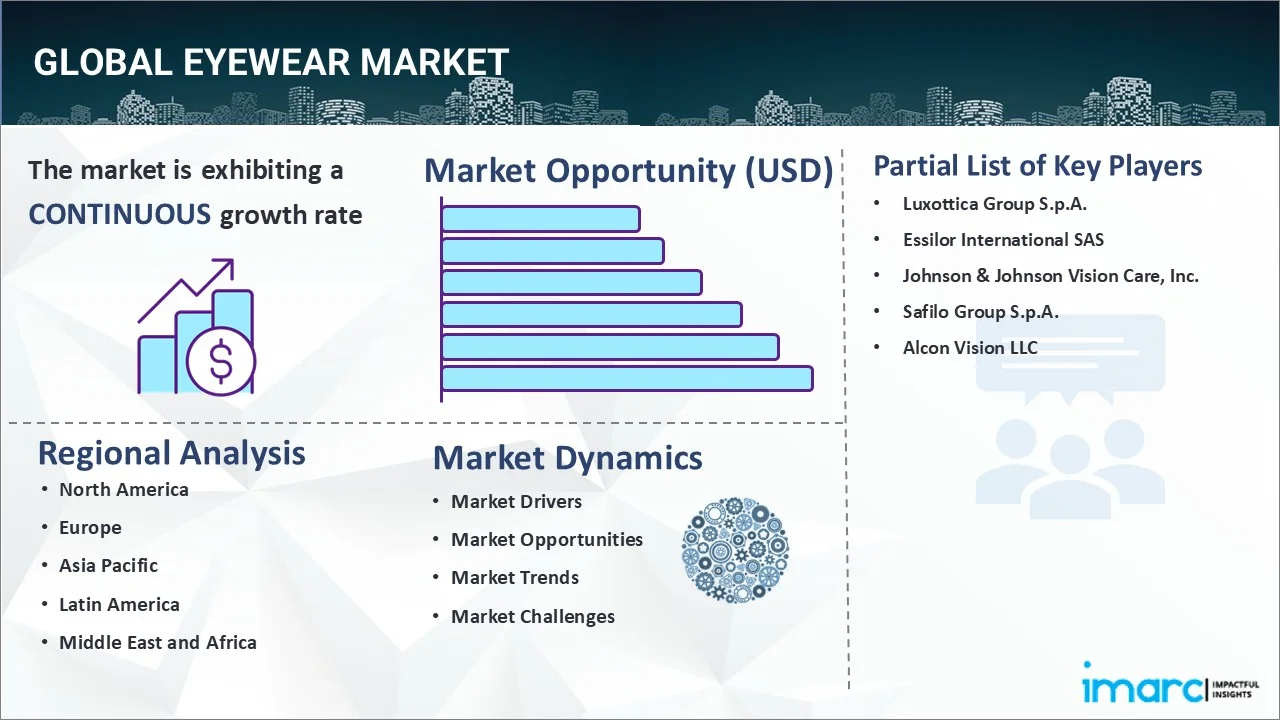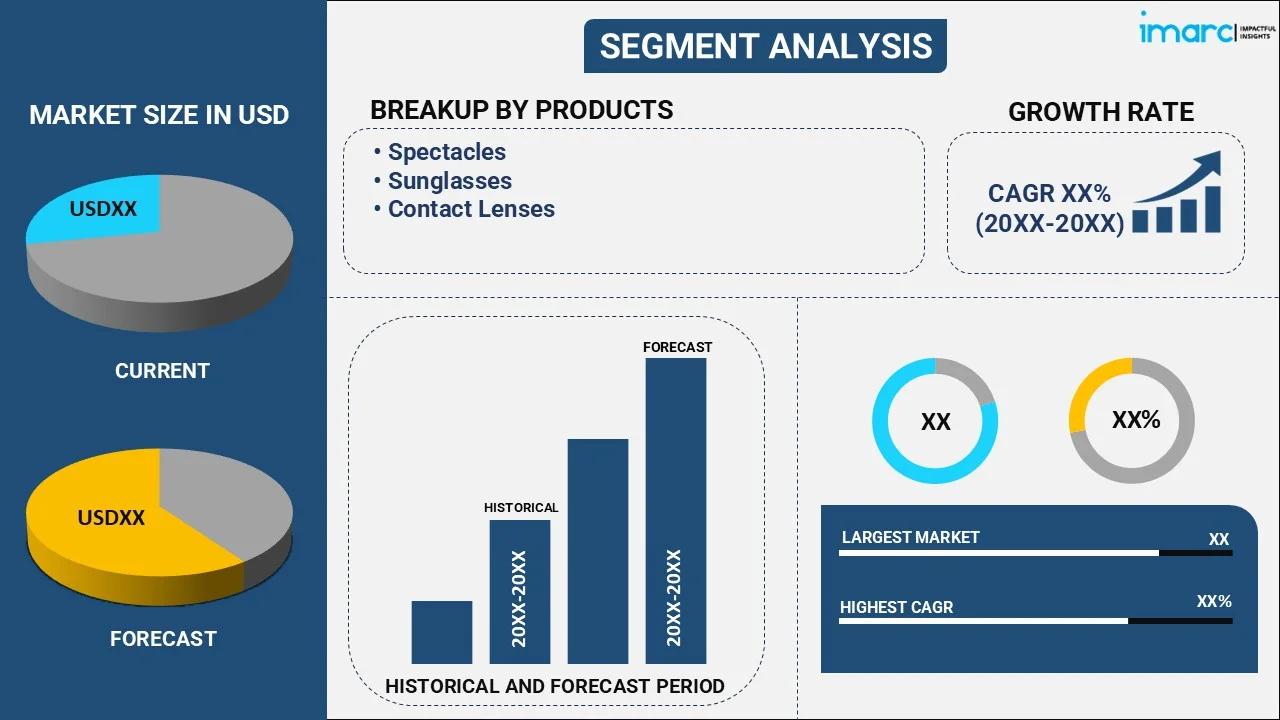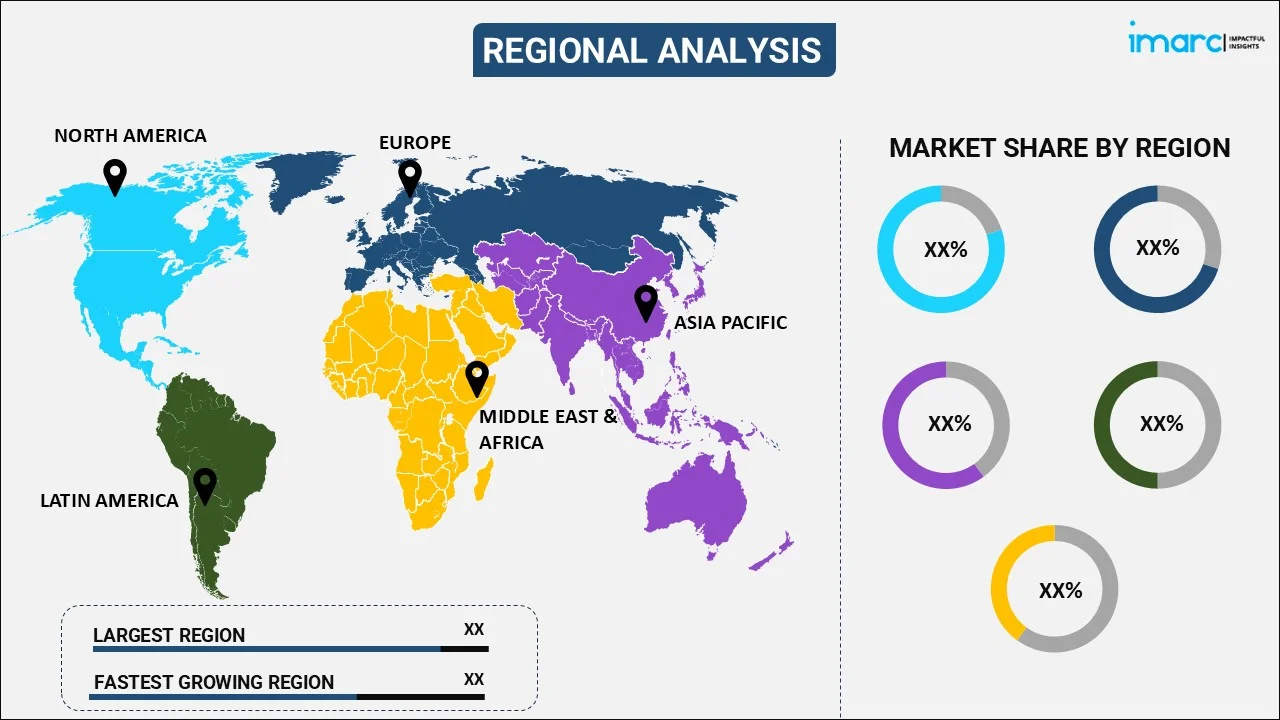
Eyewear Market Report by Product (Spectacles, Sunglasses, Contact Lenses), Gender (Men, Women, Unisex), Distribution Channel (Optical Stores, Independent Brand Showrooms, Online Stores, Retail Stores), and Region 2025-2033
Global Eyewear Market:
The global eyewear market size reached USD 169.6 Billion in 2024. Looking forward, IMARC Group expects the market to reach USD 285.9 Billion by 2033, exhibiting a growth rate (CAGR) of 6% during 2025-2033. The market is experiencing robust growth driven by factors such as the rising prevalence of visual impairments, emerging influence of fashion and lifestyle trends, rapid technological advancements in eyewear products, increasing awareness and accessibility of eye care services, and the growing disposable incomes of consumers.
|
Report Attribute
|
Key Statistics
|
|---|---|
|
Base Year
|
2024 |
|
Forecast Years
|
2025-2033
|
|
Historical Years
|
2019-2024
|
| Market Size in 2024 | USD 169.6 Billion |
| Market Forecast in 2033 | USD 285.9 Billion |
| Market Growth Rate 2025-2033 | 6% |
Eyewear Market Analysis:
- Major Market Drivers: The increasing eye health awareness, rising disposable incomes, the growing influence of fashion trends, rapid advancements in eyecare technology, and heightened awareness about eye care are proliferating the market growth.
- Key Market Trends: The rising prevalence of visual impairments, rapid technological advancements in eyewear, and the growing awareness and accessibility of eye care services are expected to stimulate the industry's growth. Additionally, the increasing focus on online retailing, which offers convenience and a wide range of choices to consumers, is bolstering the market growth.
- Competitive Landscape: Some of the prominent companies in the market include Luxottica Group S.p.A., Essilor International SAS, Johnson & Johnson Vision Care, Inc., Safilo Group S.p.A., and Alcon Vision LLC, among many others.
- Geographical Trends: According to the eyewear market dynamics, Europe exhibits a clear dominance in the market. The region is known for its strong fashion industry and cultural emphasis on style. Eyewear, including both prescription glasses and sunglasses, is increasingly viewed as a fashion accessory.
- Challenges and Opportunities: High competition among key players and shifting consumer preferences are hampering the industry's growth. However, innovations in materials, coatings, and lens technologies offer opportunities to enhance product performance, comfort, and aesthetics.

Eyewear Market Trends:
Increasing Prevalence of Visual Impairments and Eye Disorders
The rising prevalence of visual impairments and eye disorders across the globe is one of the major factors propelling the market growth. For instance, according to an article published by the U.S. Centers for Disease Control and Prevention in May 2024, approximately 12 million persons aged 40 and up in the United States have vision impairment. Also, nearly 6.8% of children under the age of 18 in the United States have a diagnosed eye or vision issue. Moreover, the growing geriatric population and lifestyle changes, leading to more screen time and increased exposure to factors that can harm eye health, are boosting the demand for eyewear. These factors are expected to drive the eyewear market growth in the coming years.
Growing Influence of Fashion and Lifestyle Changes
The growing popularity of eyewear as a fashion accessory, driven by changing consumer attitudes and the influence of fashion trends, is creating a positive outlook for the market growth. The burgeoning collaboration between the fashion industry and eyewear manufacturers, leading to the introduction of a wide range of styles, colors, and designs, is fueling the market growth. For instance, in September 2023, Italian eyeglasses producer Marcolin and German luxury fashion label MCM signed an exclusive license arrangement for the design, production, and global distribution of the brand's eyewear. These factors further positively influence the eyewear market forecast.
Product Innovations
The rising innovations in materials, design, and manufacturing processes, leading to the development of lighter, more durable, and comfortable eyewear, are positively influencing the market growth. In line with this, the introduction of polycarbonate and Trivex lenses that offer impact resistance, ultraviolet (UV) protection, and higher optical clarity are providing an impetus to the market growth. For instance, in May 2024, KOO Eyewear, a high-end Italian eyewear brand, launched its Galaxy ALIBI capsule line, which is intended to help cyclists achieve unprecedented levels of performance. Because of its deeper hue and high-performance cylindrical polycarbonate lens made by Zeiss, it offers protection from bright sunlight. These factors are contributing to the eyewear market share.
Global Eyewear Industry Segmentation:
IMARC Group provides an analysis of the key trends in each segment of the market, along with forecasts at the global and regional levels for 2025-2033. Our report has categorized the market based on product, gender, and distribution channel.
Breakup by Product:

- Spectacles
- Sunglasses
- Contact Lenses
Spectacles accounts for the majority of the market share
The report has provided a detailed breakup and analysis of the market based on the product. This includes spectacles, sunglasses, and contact lenses. According to the report, spectacles represented the largest segment.
According to the eyewear market outlook, spectacles represent the largest market share as they comprise of prescription glasses and frames. Additionally, the widespread prevalence of refractive errors, such as myopia, hyperopia, and astigmatism, necessitating the use of prescription eyeglasses, is boosting the market growth. Moreover, the rising demand for spectacles by the geriatric population, as the incidence of presbyopia increases with age, is also fueling the market growth. For instance, in 2022, in the United States, the percentage of individuals 45 years of age and older who have presbyopia ranged from nearly 83% to 88%. Furthermore, the development of lightweight, durable materials in eyewear coupled with a variety of lens options, such as anti-glare and blue light filtering, is acting as a growth-inducing factor. Besides this, the widespread adoption of spectacles owing to the heightened consumer demand for stylish frames and designer labels is enhancing the market growth.
Breakup by Gender:
- Men
- Women
- Unisex
Unisex holds the largest share in the industry
A detailed breakup and analysis of the market based on the gender has also been provided in the report. This includes men, women, and unisex. According to the report, unisex accounted for the largest market share.
According to the eyewear market overview, unisex eyewear holds the largest market share, reflecting a growing trend towards gender-neutral fashion and inclusivity in design. It is characterized by versatile designs and neutral aesthetics that resonate with the contemporary consumer's preference for functionality and style. Moreover, unisex eyewear is available in classic shapes and modern styles, ensuring widespread appeal. Besides this, the heightened popularity of unisex eyewear due to the rise of minimalist and sustainable fashion trends that focus on the simplicity and longevity of products is creating a positive outlook for the market growth. Additionally, unisex eyewear appeals to consumers who prioritize convenience and value, as these products can be shared between multiple users within a household. For instance, in June 2024, VALLON launched the Malizia, created in collaboration with Boris Herrmann and team Malizia. The Malizia are unisex performance sunglasses made for sailing. They have V52 polarized lenses.
Breakup by Distribution Channel:
- Optical Stores
- Independent Brand Showrooms
- Online Stores
- Retail Stores
Optical stores represent the leading market segment
The report has provided a detailed breakup and analysis of the market based on the distribution channel. This includes optical stores, independent brand showrooms, online stores, and retail stores. According to the report, optical stores represented the largest segment.
Optical stores represent the largest segment due to their specialized services and extensive range of products that cater to individual vision care needs. Moreover, they offer a comprehensive experience, including professional eye examinations, personalized consultations, and fittings. Besides this, the growing demand for specialty stores, as they provide the advantage of having expert opticians and eye care professionals on-site for consumers who seek assurance in the quality and accuracy of their eyewear, is enhancing the market growth. Additionally, optical stores have a wide variety of eyewear options, such as prescription glasses, contact lenses, and designer sunglasses.
Breakup by Region:

- Europe
- North America
- Asia Pacific
- Latin America
- Middle East and Africa
Europe leads the market, accounting for the largest eyewear market share
The market research report has also provided a comprehensive analysis of all the major regional markets, which include Europe, North America, Asia Pacific, Latin America, and the Middle East and Africa. According to the report, Europe accounted for the largest market share.
According to the eyewear market statistics, Europe holds the largest market share attributed to high consumer spending power, a strong presence of leading eyewear brands, and a heightened awareness of eye health. In addition to this, the growing geriatric population in the region, contributing to the demand for vision correction products, is favoring the market growth. For instance, according to an article published by the UNFPA, nearly one in 5 individuals in Europe is 65 or older. The older population in Europe is anticipated to reach 30% by 2050. Additionally, the rising demand for high-standard products and a preference for designer labels are bolstering the market growth. Moreover, the robust healthcare infrastructure and comprehensive vision care policies that make eye care services accessible to a larger population are stimulating the market growth. Apart from this, the inclination towards fashionable and technologically advanced eyewear, influenced by fashion trends and the region's focus on innovative designs and sustainable materials, is creating a positive outlook for the market growth.
Competitive Landscape:
The major players are employing various strategies to maintain and enhance their market positions. They are investing in research and development (R&D) to introduce new materials and designs while improving the comfort, durability, and functionality of eyewear. Moreover, some companies are developing lightweight, impact-resistant materials, coupled with the incorporation of digital technology in eyewear, such as augmented reality (AR) and smart lenses, favoring the market growth. Additionally, leading players are engaging in strategic mergers and acquisitions, allowing companies to expand their product portfolios and geographical reach. Furthermore, key manufacturers are leveraging social media and digital marketing to engage with a wider, more diverse consumer base.
The market research report has provided a comprehensive analysis of the competitive landscape. Detailed profiles of all major companies have also been provided. Some of the key players in the market include:
- Luxottica Group S.p.A.
- Essilor International SAS
- Johnson & Johnson Vision Care, Inc.
- Safilo Group S.p.A.
- Alcon Vision LLC
(Please note that this is only a partial list of the key players, and the complete list is provided in the report.)
Eyewear Market Recent Developments:
- July 2024: Jrue Holiday, a Boston Celtics guard, collaborated with Zenni Optical, an online eyewear company, to launch a customized collection of spectacles.
- June 2024: VALLON launched the Malizia, created in collaboration with Boris Herrmann and team Malizia. The Malizia are unisex performance sunglasses made for sailing. They have outstanding V52 polarized lenses.
- May 2024: KOO Eyewear, a high-end Italian eyewear brand, launched their Galaxy ALIBI capsule line, which is intended to help cyclists achieve unprecedented levels of performance.
Eyewear Market Report Scope:
| Report Features | Details |
|---|---|
| Base Year of the Analysis | 2024 |
| Historical Period | 2019-2024 |
| Forecast Period | 2025-2033 |
| Units | Billion USD |
| Scope of the Report | Exploration of Historical Trends and Market Outlook, Industry Catalysts and Challenges, Segment-Wise Historical and Predictive Market Assessment:
|
| Products Covered | Spectacles, Sunglasses, Contact Lenses |
| Genders Covered | Men, Women, Unisex |
| Distribution Channels Covered | Optical Stores, Independent Brand Showrooms, Online Stores, Retail Stores |
| Regions Covered | Asia Pacific, Europe, North America, Latin America, Middle East and Africa |
| Companies Covered | Luxottica Group S.p.A., Essilor International SAS, Johnson & Johnson Vision Care, Inc., Safilo Group S.p.A., Alcon Vision LLC, etc. |
| Customization Scope | 10% Free Customization |
| Post-Sale Analyst Support | 10-12 Weeks |
| Delivery Format | PDF and Excel through Email (We can also provide the editable version of the report in PPT/Word format on special request) |
Key Benefits for Stakeholders:
- IMARC's report offers a comprehensive quantitative analysis of various market segments, historical and current market trends, market forecasts, and dynamics of the eyewear market from 2019-2033.
- The research study provides the latest information on the market drivers, challenges, and opportunities in the global eyewear market.
- The study maps the leading, as well as the fastest-growing, regional markets.
- Porter's five forces analysis assists stakeholders in assessing the impact of new entrants, competitive rivalry, supplier power, buyer power, and the threat of substitution. It helps stakeholders to analyze the level of competition within the eyewear industry and its attractiveness.
- The competitive landscape allows stakeholders to understand their competitive environment and provides insight into the current positions of key players in the market.
Key Questions Answered in This Report
The global eyewear market was valued at USD 169.6 Billion in 2024.
We expect the global eyewear market to exhibit a CAGR of 6% during 2025-2033.
The high prevalence of ocular diseases, along with the growing demand for advanced glare-free prescription eyewear with enhanced durability, is currently catalyzing the global eyewear market.
The sudden outbreak of the COVID-19 pandemic has led to the increasing consumer inclination towards online retail platforms for the purchase of eyewear, as numerous key players are integrating their services with product virtualization and facial analysis to remotely recommend apt eyewear designs for individuals.
Based on the product, the global eyewear market can be segmented into spectacles, sunglasses, and contact lenses. Among these, spectacles hold the majority of the total market share.
Based on the gender, the global eyewear market has been divided into men, women, and unisex. Currently, unisex eyewear exhibits a clear dominance in the market.
Based on the distribution channel, the global eyewear market can be categorized into optical stores, independent brand showrooms, online stores, and retail stores. Among these, optical stores currently hold the largest market share.
On a regional level, the market has been classified into North America, Asia Pacific, Europe, Latin America, and Middle East and Africa, where Europe currently dominates the global market.
Some of the major players in the global eyewear market include Luxottica Group S.p.A., Essilor International SAS, Johnson & Johnson Vision Care, Inc., Safilo Group S.p.A., and Alcon Vision LLC.
Need more help?
- Speak to our experienced analysts for insights on the current market scenarios.
- Include additional segments and countries to customize the report as per your requirement.
- Gain an unparalleled competitive advantage in your domain by understanding how to utilize the report and positively impacting your operations and revenue.
- For further assistance, please connect with our analysts.
 Request Customization
Request Customization
 Speak to an Analyst
Speak to an Analyst
 Request Brochure
Request Brochure
 Inquire Before Buying
Inquire Before Buying




.webp)




.webp)












